When we think of color-changing animals, the first thing that comes to mind is lizards. However, there are at least two snakes out there that change color to blend in. Some do it for other reasons as well, though it is not well understood.
The process by which reptiles change color is known as metachrosis. Only one snake on the planet is known to change its color, like the famous chameleon. Another changes the color it was born with when springing into adulthood so it can match where it lives.
All snakes become clouded when they’re shedding, and the dramatic dulling of color can be worrisome to people tending to these snakes. It’s a natural part of a snake’s lifecycle, and depending on the snake, it usually takes a week for it to return to looking normal.
What are those two snakes that change color to blend in? What other snakes change color? A deeper dive is needed, so let’s get started.
2 Snakes That Change Color to Blend In
The two snakes that change color to blend in are:
- Green Tree Python
- Kapuas Mud Snake
The Green Tree Python
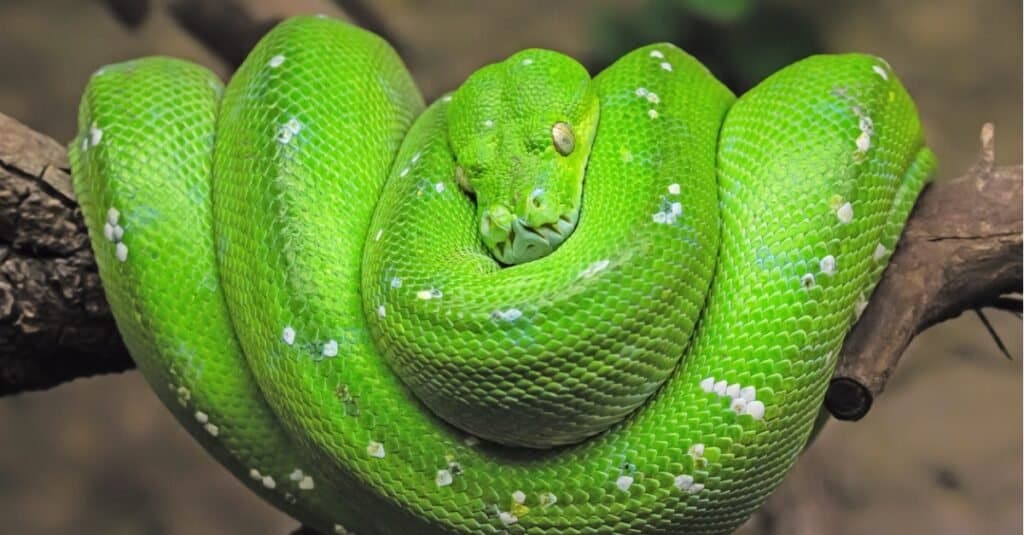
Green tree python adults are green to match tree leaves.
©iStock.com/tane-mahuta
While green tree pythons don’t change color on demand, they are born either red or yellow. They undergo an ontogenic change as they mature, becoming green as adults. Both color stages are related to blending into their environment.
Youngsters like the edge of the forest for their smaller prey, whereas adults hang out at the tops of trees. The yellow better matches the litter on the ground around the forest’s edge, while the green better matches the foliage in the trees. It takes about six months to a year for their coloring to change.
You’ll find green tree pythons in northeastern Australia and New Guinea. They also come in unique natural patterns due to their isolation on islands, though all are brilliant green in adulthood.
The Kapuas Mud Snake
Dubbed the chameleon snake, the Kapuas mud snake quickly changes color to blend in. In 2006, scientists discovered this snake in Borneo. Through their experiments, they realized the animal changed from brownish to white when they put it in a bucket.
The Kapuas River is where the Kapuas mud snake got its name. It’s also called a mud snake because it likes to hide in mud.
3 Boa Constrictors That Change Color Because of the Sun
There are three boas that change color because of the sun. They are:
- The Round Island Keel-Scaled Boa
- The Colombian Rainbow Boa
- The Hog Island Boa Constrictor
The Round Island Keel-Scaled Boa
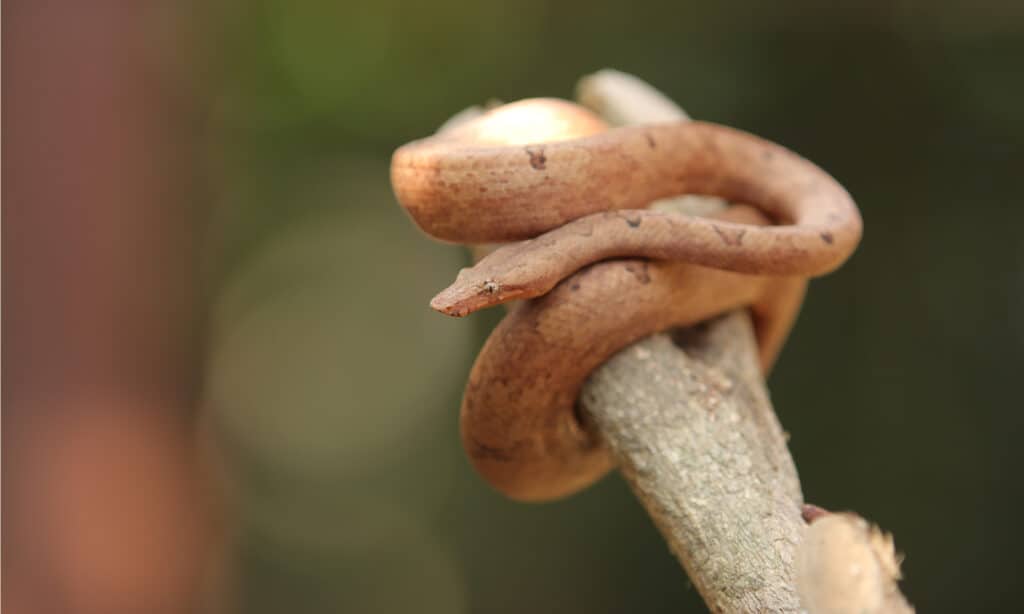
The Round Island keel-scaled boa slowly changes color over 24 hours.
©Mufti Adi Utomo/Shutterstock.com
Round Island is a small island in the Indian Ocean off the coast of Mauritius. The Round Island keel-scaled boa calls this island home. Interestingly, Mauritius is home to zero amphibians.
Since the 18th century, Mauritius has been devastated by human development. It has recently been turned into a nature conservatory so that palm savannahs can be reestablished for native populations of various animals. The keel-scaled boa is on that list.
The vegetation on the island had been decimated by introducing herbivores like goats, so all the domesticated animals eating natural plant resources were removed. This has monumentally helped with the re-establishment of reptile populations in Mauritius.
During the heat of the day, the round island keel-scaled boa is much darker than it is at night, and the snake slowly changes during 24 hours. Polychromatic cells in the skin are what allow this to happen.
The Colombian Rainbow Boa
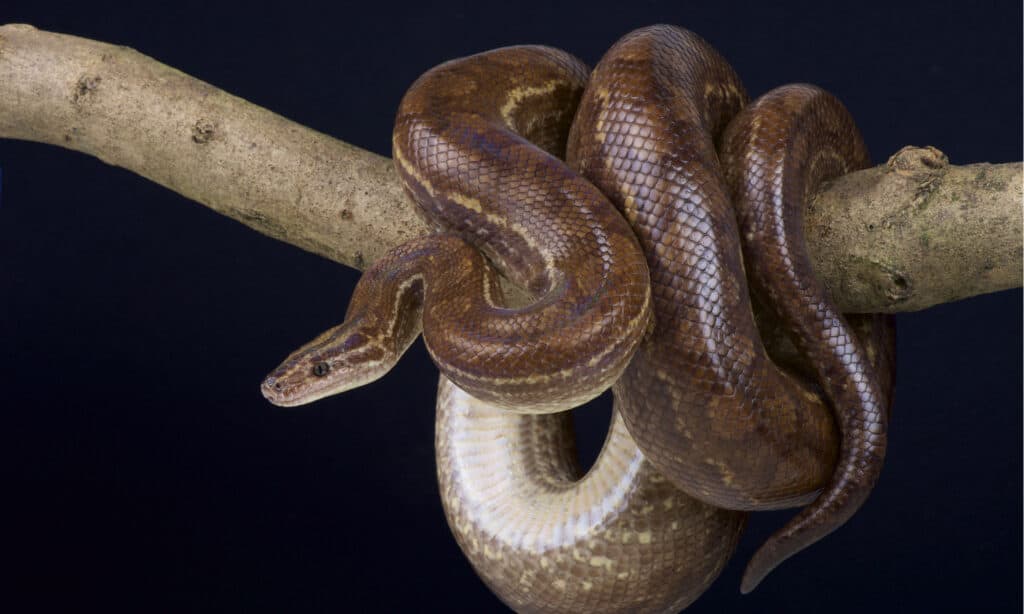
The Colombian rainbow boa has an iridescent sheen over it in the sunlight.
©reptiles4all/Shutterstock.com
Hanging out in both trees and on the ground, the Colombian rainbow boa lives in the Amazon. Having one as a pet is common as they’re easier to keep than some other kinds of snakes. There are also some awesome-looking morphs of this snake in captivity.
During the day, the Colombian rainbow boa has an almost oil-slicked sheen over its brown and tan blotched body. At night, that sheen is completely gone.
The Hog Island Boa Constrictor

Hog Island boa constrictors change from light to dark.
©fivespots/Shutterstock.com
Found on Hog Island off the coast of Honduras, the Hog Island boa constrictor changes from light to dark. It’s darker at night and lighter during the day. It fluctuates between off-white and darker colors.
Hog Island boa constrictors are common pets, but the pet trade has decimated their wild populations. A feature that makes them somewhat unique is that they prefer tropical rainforest habitats. Most boas prefer dry and arid places.
It is believed that these snakes may also change color based on their mood, though that’s anecdotal, and there isn’t scientific evidence confirming this.
2 Rattlesnakes That Change Color
Two rattlesnakes that change color are:
The Prairie Rattlesnake
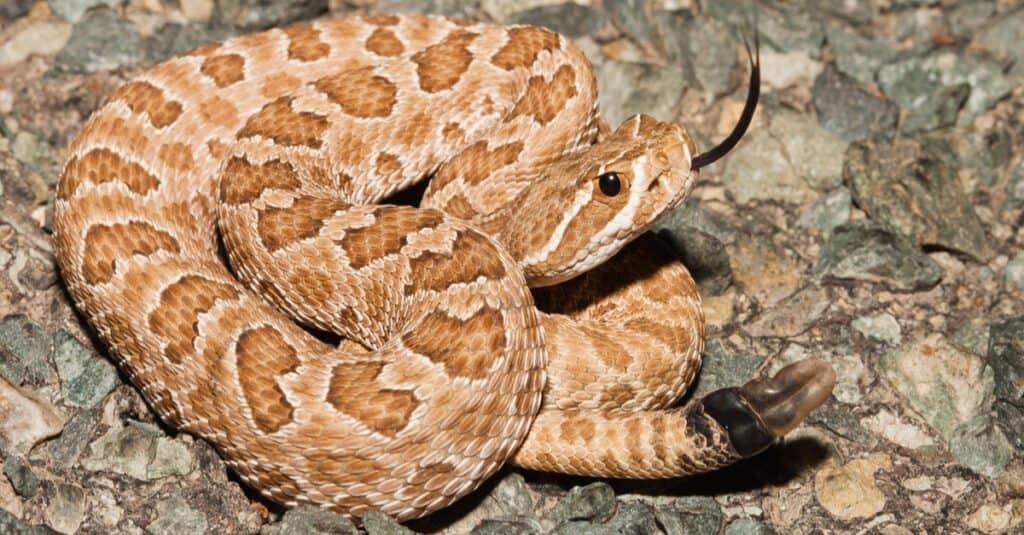
Prairie rattlesnakes might change color due to temperature.
©Nathan A Shepard/Shutterstock.com
Early research shows that the prairie rattlesnake changes color. This is due to the concentration of melanin in specific areas that can be moved around. A specific hormone controls how melanin appears on the skin, and when the organ that processes this hormone was removed from lab snakes, the snakes were no longer able to change color and turned cream.
Another experiment showed that when the snakes are exposed to high temperatures, they lighten, and when they’re exposed to low temperatures, they darken. This may be related to light absorption, with dark skin sucking in more UV rays than light skin.
Like all rattlesnakes, this one is highly venomous, but it won’t seek a fight. It lives east of the Rocky Mountains in arid places.
The Arizona Black Rattlesnake
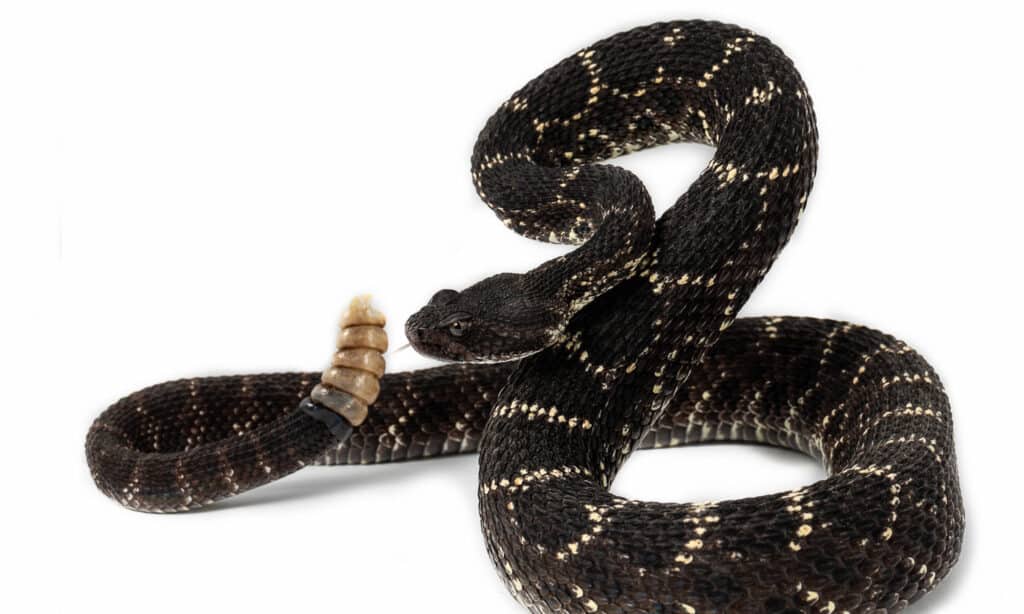
Black rattlesnakes most likely change color for the same reason as prairie rattlesnakes.
©Scott Delony/Shutterstock.com
It is unknown why the Arizona black rattlesnake changes color, but it’s believed to be closely linked to its relative, the prairie rattlesnake. This snake is located almost exclusively in the San Francisco mountains in northern Arizona.
It is called the black rattlesnake because it is darker than some of its relatives living in more desert-like regions. Changing color happens in minutes, with its characteristic black turning grey.
The photo featured at the top of this post is © Nathan A Shepard/Shutterstock.com
Discover the "Monster" Snake 5X Bigger than an Anaconda
Every day A-Z Animals sends out some of the most incredible facts in the world from our free newsletter. Want to discover the 10 most beautiful snakes in the world, a "snake island" where you're never more than 3 feet from danger, or a "monster" snake 5X larger than an anaconda? Then sign up right now and you'll start receiving our daily newsletter absolutely free.
Thank you for reading! Have some feedback for us? Contact the AZ Animals editorial team.






